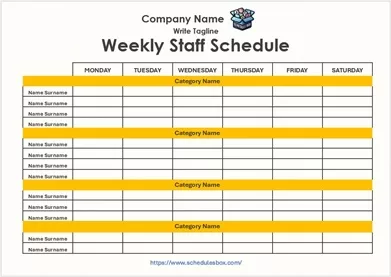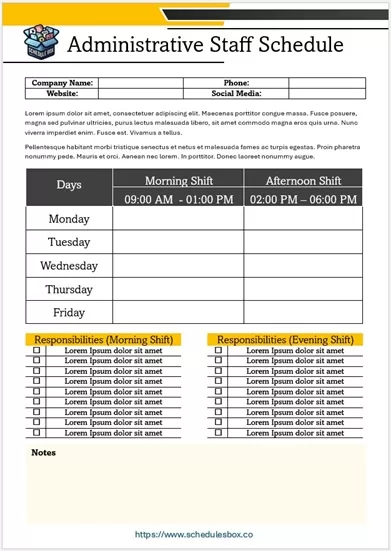It is not easy to manage staff and their daily, weekly and monthly activities as well as working hours in a small, medium, or large-scale business. In order to cover all shifts properly, you need to devote much time and close attention. A newbie will not be able to identify with his or her staff schedule given a lack of any previous experience in doing so. As such, heavily structured staff schedule templates could be utilized and the potential exists for simplification minus tension.
Where to Find These Staff Schedule Templates?
Getting these templates is not as difficult as you may believe. A lot of options are available on the internet and it is by visiting these sites where you can look for staff schedules that suit you best in terms of templates. Moreover, some websites charge for downloaded templates despite being free.
How to Design Flexible Staff Schedules?
Authoring an employee shift schedule file can be difficult. However, the following ready-made templates can make it easier for you to plan the working hours of employees. These templates have good customization options. At any time, you want, insert new data into your list, change it, or print out its updated version.
Key Components of Staff Schedule
Here, you can figure out the key components that this workforce schedule tool provides for better planning and time tracking:
The Staff Names section is one of the most important parts of any scheduling template because it provides a space where names for employees can be written specifically. With all the names in one location, locating and recognizing team members becomes simpler making it easier to track their assignments and shifts. This also eases off confusion particularly where there is more than one shift with many employees under control.
The Role field emphasizes the kind of job a worker does or his/her duties at work. By defining roles, task allocations are distributed according to the abilities people have and the work they are supposed to do therefore ensuring the smooth operation of an organization. Managers, assistants, and specialists can each have separate functions assigned to them. Such a step would see their effort converge at bringing achievement to the group and also make it possible for everyone to know what needs to be done by the close of business.
The Start Time field helps supervisors keep accurate records of what time each shift starts, as well as being useful when it comes to punctuality and responsibility. Keeping up with starting times also aids in planning shifts hence ensuring a smooth movement from one shift to another while at the same time making sure that the hours of work conform with the needs of the organization.
Similarly, the Last Time column records how long (when) the work was over for each worker per day. Therefore, keeping track of the time after work helps in paying wages with precision, attendance supervision, and making sure that employees are not overburdened. That much is very important when it comes to observing labor laws since some may have set limits on how long (many hours) one should work continuously without a break.
Lunch Breaks are a highly important element of employee scheduling. Allotted pauses give workers the opportunity to relax, recharge, work efficiently, and maintain a good atmosphere. Specific intervals of rest also cultivate better corporate culture as they are believed to reduce work-related tension and promote concentration.
In the Working Hours section, we calculate the total hours spent on the job by each employee, incorporating any extra hours. For a fair payment to employees, tracking the actual hours worked is essential as it aligns with company policies and compliance requirements. This specific section is essential when it comes to dealing with overtime and modifying shifts depending on workload fluctuations.
The integration of these elements in a staff timetable can enable supervisors and managers to effectively track their workers in terms of hours worked, roles assumed, or break-off times. These well-organized systems will enhance more effective control of employees making sure they produce quality outcomes during projects’ execution which would normally correspond with sound motivational levels among the workforce.
Free Staff Schedule Templates
Here are previews and download links for these Free Staff Schedule Templates in MS Word and MS Excel format.
Types of Staff Schedules
There are several types of staff schedules, each designed to meet different needs and operational requirements. Here are some of the most common types:
- Fixed Schedule
- Flexible Schedule
- Rotating Schedule
- Split Shift
- Compressed Workweek
- On-Call Schedule
- Seasonal Schedule
- Shift Work
- Remote Work Schedule
- Project-Based Schedule
Each type of staff schedule serves different operational needs and employee preferences, and choosing the right type depends on the nature of the work, the organization’s requirements, and the employees’ needs.
Tips to Create Staff Schedules
It’s crucial for shift workers’ organizations to have a well-arranged and healthy roster. Here are several crucial hints that will help you make a perfect work plan for your staff.
Be Thoughtful
Managers and supervisors must know individual employees in order to design staff schedules while considering employees’ strengths for the positions that they fit best.
Clear Communication
Inform all the workers about the timetable. Put it in their hands and forward by electronic mail or another appropriate system. This way, no one will dodge his/her duty split. Also, there should be a mechanism for staff to receive alerts in case of any sudden alterations to their work rota so that managers can be certain nobody will fail during shifts.
Planning Ahead
It is crucial for better planning to be carried out ahead of time so as to deal with employee equilibrium. This is where interaction with the workers comes along and where a better schedule in terms of efficiency and result is done.
So, staff scheduling is an ideal solution for supervisors to streamline the workflow and planning process for a balanced working hour distribution. Therefore, to bring organizations into your daily business operations, having a proper staff schedule template is inevitable.













